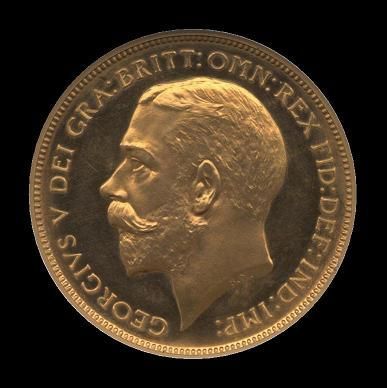
1911 Double-Pound

George's coronation was on the 22nd of June 1911 and, like for his father, proof sets with varying numbers of
pieces were issued in that year. Two of the sets included gold, the first containing 12 coins from the five-pound
down to the Maundy Penny. The second was the same as the first but did not include the five- or two-pound piece.
A third proof set with 8 coins was struck that consisted of the halfcrown down to the Maundy Penny. In 1927 a fourth
proof set was issued having 6 coins. This was of the new type of coins and consisted of the new crown (Wreath style),
halfcrown, florin, shilling, sixpence, and the threepence. Sets that are complete with original cases are worth
a bit more than non-cased sets, or sets in generic cases.
Gold coins were struck in various mints besides London and include Ottawa, Bombay, Melbourne, Perth, Sydney, and Pretoria.
See here for the mintmarks used and for their locations on
the coins. Additional mintmarks were used to identify the Heaton and King's Norton issues of Penny. See
here for their location on the coins.
There are several types issued for many of the denominations and collecting them all can be a bit of a challenge
owing to the subtleties in them. For example is the Old vs Modified Effigy types. The differences between them
vary by denomination. See here for ways to determine the difference
on some of the various denominations.
In 1923 there was also a change in the composition of the penny, halfpenny, and farthing. Up until 1922, the
composition was .950 copper, .040 tin, and .010 zinc. From 1923 until World War II, the composition was
changed to .955 copper, .030 tin, and .015 zinc. In 1920, silver coins were also debased and went from .925 fine
to .500 fine.
Monarchs of England and Great Britain | Coins of England and Great BritainGeorge V of Great Britain (1911-1936)

1911 Double-Pound